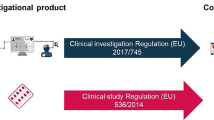Abstract
Pharmaceutical industry drug development portfolios vary in breadth and depth. For each firm, however, the objective of improving the success rate of their marketing applications is paramount. Understanding some of the characteristics associated with marketing application success and alternatively some of the pitfalls associated with application failure may assist firms in developing more efficient drug development strategies. The purpose of this article is to review briefly some of the research that has been conducted, take note of current trends, underscore potential biases, and affirm the contribution that regulatory professionals can bring to the drug development process.
Similar content being viewed by others
References
DiMasi JA. Uncertainty in the drug development: approval success rates for new drugs, clinical drug trials and tribulations. In: Cato A, Sutton L, Cato A III, eds. Drugs and the Pharmaceutical Sciences. Vol 120. New York: Marcel Dekker; 2002.
Adams CP, Brantner VV. New Drug Development: Estimating Entry From Human Clinical Trials. Bureau of Economics, Federal Trade Commission, July 2003. Working Paper No. 262.
Gray N. Predicting success: a pipeline report. Pharm Exec. 2003;23:54–66.
Abrantes-Metz R, Adams C, Metz A. Pharmaceutical Development Phases: A Duration Analysis. Washington, DC: Federal Trade Commission; 2003.
Carpenter D, Turenne M. Why do bigger firms receive faster drug approvals? Department of Political Science. University of Michigan; 2000.
DiMasi JA. Success rates for new drugs entering clinical testing in the United States. Gin Pharmacol Ther. 1995;58:1–14.
DiMasi JA, Hansen RW, Crabowski HG, Lasagna L. Research and development costs for new drugs by therapeutic category: a study of the US pharmaceutical industry. Pharmacoeconomics 1995;7:152–169.
US Regul Rep. February 2006;22 (no. 8).
US Regul Rep. April 2006;22 (no. 10).
Genovese MC, Harris ED. Treatment of rhematoid arthritis. In: Harris ED, Budd RC, Firestein GS, et al., eds. Kelley's Textbook of Rheumatology. Vol 2. Philadelphia. PA: Elsevier Saunders: 2005;1079–1099.
Weinblatt ME, Kremer JM, Bankhurst AD, et al. Phase II/III trial of TNF receptor p75 Fc fusion protein in combination with methotrexate in RA patients. Arthritis Rheum. 1998;41(suppl 9): S189.
Lytton M. Nothing ventured: why clinical trials fail unexpectedly. Start-Up. April 2006:50–51.
Elias T, Gordian M, Singh N, Zimmel R. Why products fail in phase III. In Vivo. April 2006; 49–54.
Kradjian S. Regulatory risk assessment in early development. Focus. March 2006:22–27.
Author information
Authors and Affiliations
Corresponding author
Rights and permissions
About this article
Cite this article
Maniglia, C.A. The Probability of Registrational Success. Ther Innov Regul Sci 41, 345–347 (2007). https://doi.org/10.1177/009286150704100307
Published:
Issue Date:
DOI: https://doi.org/10.1177/009286150704100307




